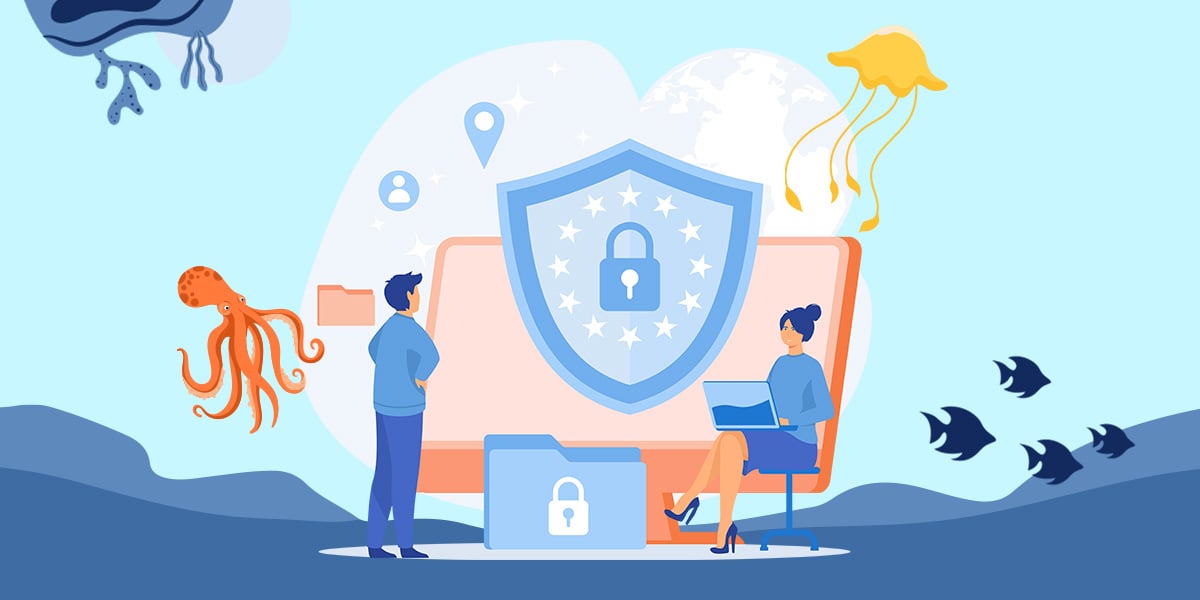


MSPs' Top 5 Security Awareness Questions from Clients



Delivering top-tier IT services requires collecting data from your clients, and it's only natural they'd want to know how you're protecting that valuable information.
Part of your answer may involve proactive security awareness training — depending on your clients, your contract might even mandate this ongoing education as part of your information security program. Here are the top five questions your clients might have about security awareness.
An Introduction to Security Awareness Training for MSPs
Security awareness training refers to teaching employees general information security practices. These courses defend your business from cyber threats by increasing awareness of them and teaching how to mitigate them.
At Phin Security, we provide an intuitive and engaging training platform for MSPs serving customers across all industries. Our program covers essential cybersecurity concepts like these.
- Physical security: This domain includes basic protective measures such as keeping desks clear of sensitive or confidential information, not letting someone snoop over your shoulder or eavesdrop, and not letting people “tailgate,” or follow you into locked areas.
- Email and communications security: In this unit, we cover how to securely share information and how to spot social engineering attacks and phishing emails.
- Rule following: Employees will learn why they should not circumvent security safeguards on a computer even if it boosts their efficiency.
- Reporting: Our platform guides your employees through reporting security incidents quickly and confidently.
- Resource use: Our program also covers guidelines for the acceptable use of information technology resources.
Depending on what industries you serve, you may need to train your team about other specialized topics. Be mindful of those and do your research. For example, if you’re in health care, you must comply with HIPAA.
You also have enhanced fines and public reporting requirements depending on the size and quality of the data breach. You are responsible for teaching your staff about those.
How Security Awareness Training Elevates the Client-Service Provider Relationship
Your team manages and maintains clients' IT infrastructure, which often involves handling sensitive data. Your clients must trust you with their valuable resources.
Regular security awareness training demonstrates your commitment to cybersecurity, which can:
- Strengthen your reputation as a reliable partner
- Improve customer satisfaction
- Increase customer retention rates
Additionally, it can save your MSP money by avoiding noncompliance penalties with essential industry standards like GDPR and HIPAA.
1. What Staff Training Do You Provide?
Before anything else, your clients want to know:
- Whether you provide security awareness training to your workforce
- The topics your training program covers
- How often you deliver this training
You should train your workforce in general security awareness at least annually. However, we recommend scheduling more frequent sessions to reinforce lessons and build on the benefits.
Finding the Correct Training Frequency for Your MSP
You can train as often as you like in multiple formats to expose your staff to more diverse information security issues.
One comprehensive annual training session provides a sound, auditable point. You can use an industry-standard benchmark to market and represent your efforts.
Keep detailed records of your results if you train more often. This documentation can provide an excellent benchmark to highlight your security program's effectiveness to potential customers.
You can also use this data to market how your training has improved your operational safety. Safer operations translate to high availability, better data integrity, and lower data loss or exfiltration.
In addition to satisfying your clients, you'll also make your business and cyber insurance happy.
2. Do You Provide Phishing Training?
Phishing is the leading cause of information security incidents. Not providing phishing training is negligent, at best. Realistically, failing to provide phishing training is practically inviting a ransomware attack.
Phishing Training as a Core Component of Security Programs
Phishing training comes in many forms. While a conversation around phishing training baselines is valuable, your clients want to know how actively you prepare for this common and devastating threat.
As with general staff training, this is an excellent opportunity to highlight ways your organization stands out. You can’t go wrong by doing more in this space — you’ll look more sophisticated to your clients and do a better job of avoiding costly data breaches.
Enhancing Business Safety Measures Through Phishing Awareness

Conducting regular live phishing exercises is one way to set yourself apart. This activity includes sending phishing emails to your staff linked to training modules, which simulate real-world phishing emails. You will prepare your team to identify and stop these attacks in their tracks by providing real-world examples of this threat in action.
Your clients may also have questions about training for other human-based attack vectors, which may include the following.
- Social engineering attacks: Communication-based attacks that rely on the fight-or-flight response and routine activity to steal information, money, or account credentials.
- Intentional internal threats: Jaded and disgruntled employees wishing to cause harm often attack by stealing or destroying sensitive data.
- Mistakes: Misdirected information is a primary cause of some of the costliest data breaches in recent years. Are you providing error management training to your staff?
3. Do You Cultivate a Culture of Security or Safety?
Building a training program can be a meteoric effort. Undertaking that programmatic approach to security is an excellent way to highlight your seriousness about information security and protection.
That work effort can be for naught if you don’t also enforce a culture of security or safety. If you only pay lip service to security or use requirements as a check-the-box exercise, your workforce may find it challenging to take security seriously and apply their training to practical issues.
A culture of safety and security is an excellent metric for your clients to understand that you build awareness and apply it in everything you do. It shows that you take security as seriously as data protection. It’s an encouragement and motivation to share data that can improve various operational aspects.
Building a Security Awareness Culture in Your Organization
Building a culture of security or safety is a top-down exercise. Executive leadership needs to task the organization with managing information governance. The workforce must hear that there’s a solid commitment to enabling security-forward practices.
Maintaining a culture of security or safety is a bottom-up exercise. Everyone needs to work securely and be mindful of security best practices. Those best practices should be integral to enterprise processes, projects, infrastructure, and operations.
Critically, it’s vital to drive measurable and verifiable metrics that:
- Motivate your culture of security and safety
- Benchmark your culture against industry peers
- Highlight to clients how well your security awareness program operates
4. Do You Know What Your Vendors Do?
While your workplace ethos is critical to implementing a security awareness program, your clients may insist you take that awareness further afield of your organization with a third-party risk management program.
Understanding Vendor Activities for Comprehensive Security
At the highest level, a TPRM observes your vendors’ and data exchange security posture. However, most TPRM programs do more than that. Some iterations evaluate the technical perimeter of your vendors and data exchange partners. Other aspects of TPRM programs include administrative security evaluations to determine your vendors’ security frameworks and how well they manage them.
Whatever your TPRM program looks like, you’ll benefit by implementing a program that provides good visibility into what your vendors do. A program like this promotes confidence among all parties, while providing insight into your complete risk profile. You’re unlikely to grasp that well without a TPRM program in place.
A TPRM program also keeps communication lines open between you and your vendors, specifically about information security issues.
By integrating security into every aspect of organizational operations, inside and out, you demonstrate the quality and importance of security. That, in turn, bolsters how important your workforce treats the quality and significance of security.
Additionally, a quality TPRM program lets you extend your security awareness to other organizations that provide critical support and supply chain needs. The last thing you want is to lose support or have a crippled supply chain due to information security issues. You also don’t want to entrust a vendor with significant quantities of data, only to have them exfiltrate it during a breach.
5. How Do You Manage Risk?
One side of the security awareness equation is vital education and practice development. The other side is active risk management, where the rubber meets the road. We alluded to that in the previous section regarding TPRM, but more generally, good security awareness means being cognizant of and actively managing risk.
How you manage risk depends on several details about your organization, including:
- Size
- Structure
- Complexity
- Assets
While security awareness is only one component of a thriving risk management program, it significantly contributes to that program’s quality.
Addressing Common MSP Security Challenges Through Proactive Measures
Your clients may request that you have a risk management program. They may even ask you to provide the byproducts of that risk management program for their TPRM program. Whether you want to disclose those is a personal decision based on what you generate and the sensitivity of that information to your organization.
However, a formal risk management program and its performance measures attract customers. As with other aspects of a security awareness program, it demonstrates whether:
- You consider client data security in your everyday operations
- You act on those considerations
- Your company takes a proactive approach to monitoring the information security threat landscape
The third point is especially critical — whatever risk management program you implement must incorporate threat feeds and intelligence. Many services assist in that space and will help you learn about and mitigate some of the most current information security threats.
Choose Security Awareness Training Designed Specifically for MSPs
We know you receive a lot of questions from clients about what you're doing to protect their information, and the best way to prepare for these questions is to be aware.
Building security features into your overall risk management program will help you understand your place in the information security threat landscape so you can effectively defend against evolving risks and put your clients at ease.
That's where Phin Security comes in. Our user-friendly security awareness training and phishing simulation solutions can help you achieve your goals with powerful features designed to simplify employee training. And since it only takes 10 minutes to set up, you can start immediately.
See why top MSPs choose Phin Security to deliver their security training materials. Request your free trial today to get started.







Leave a comment: